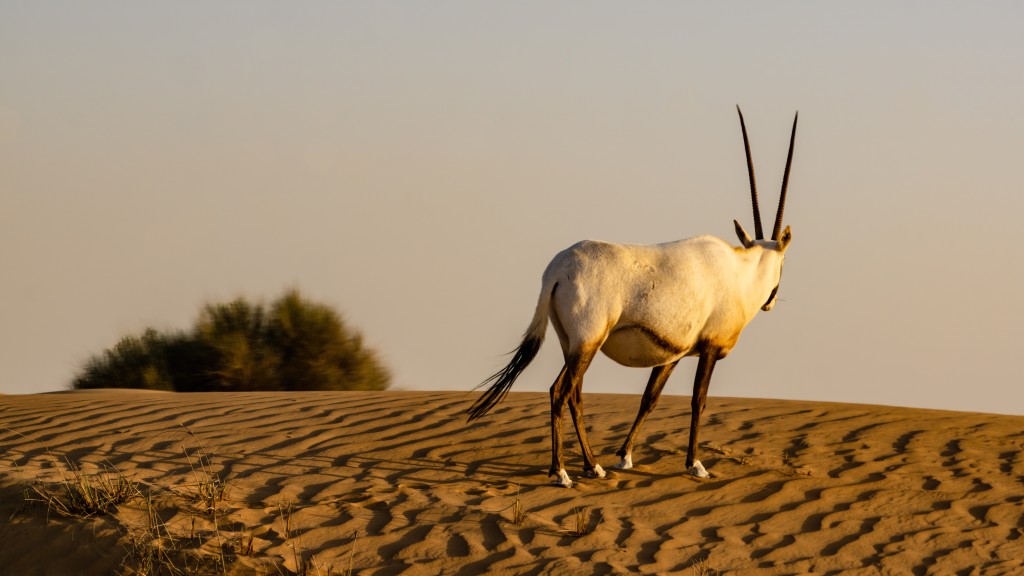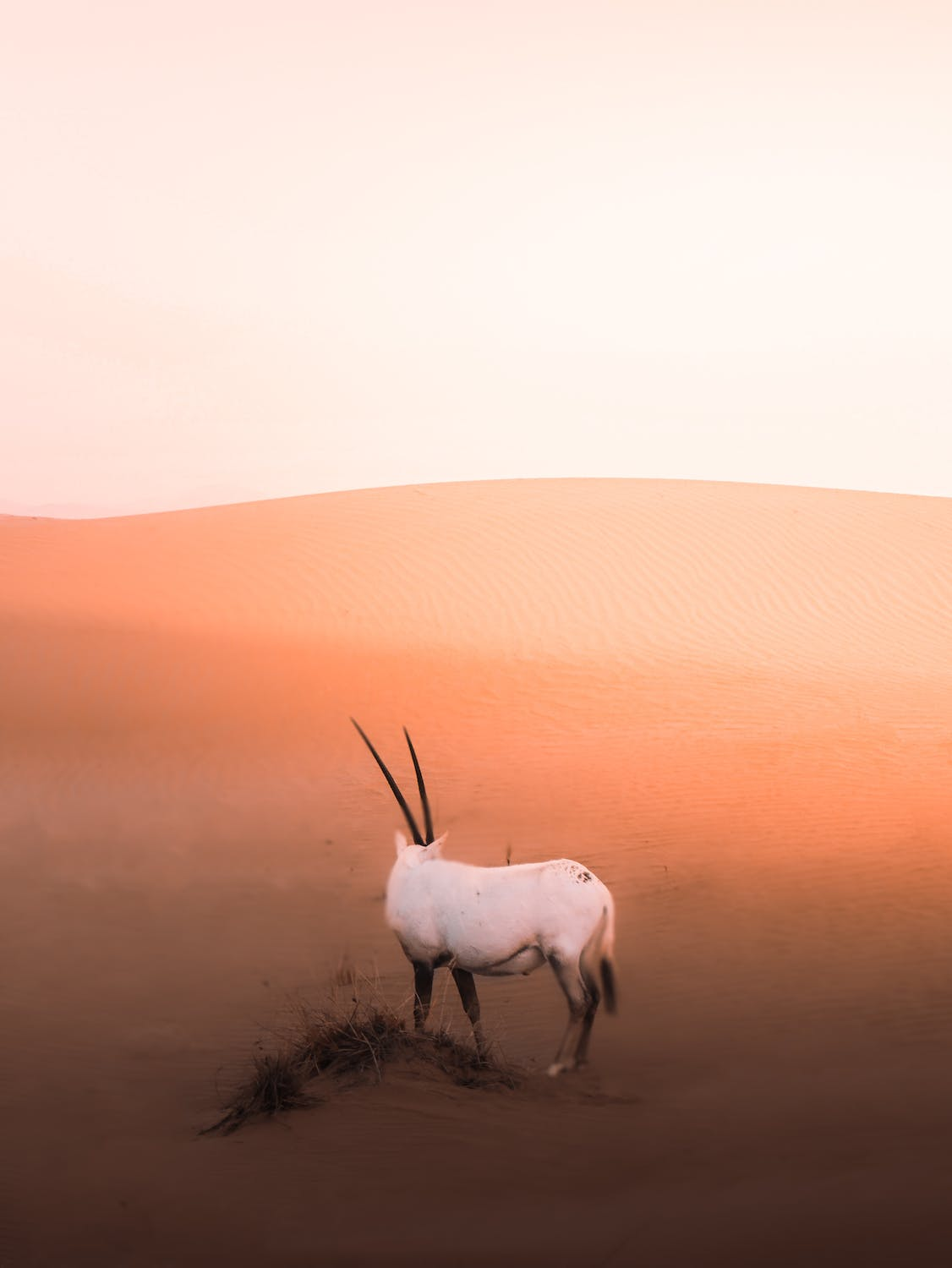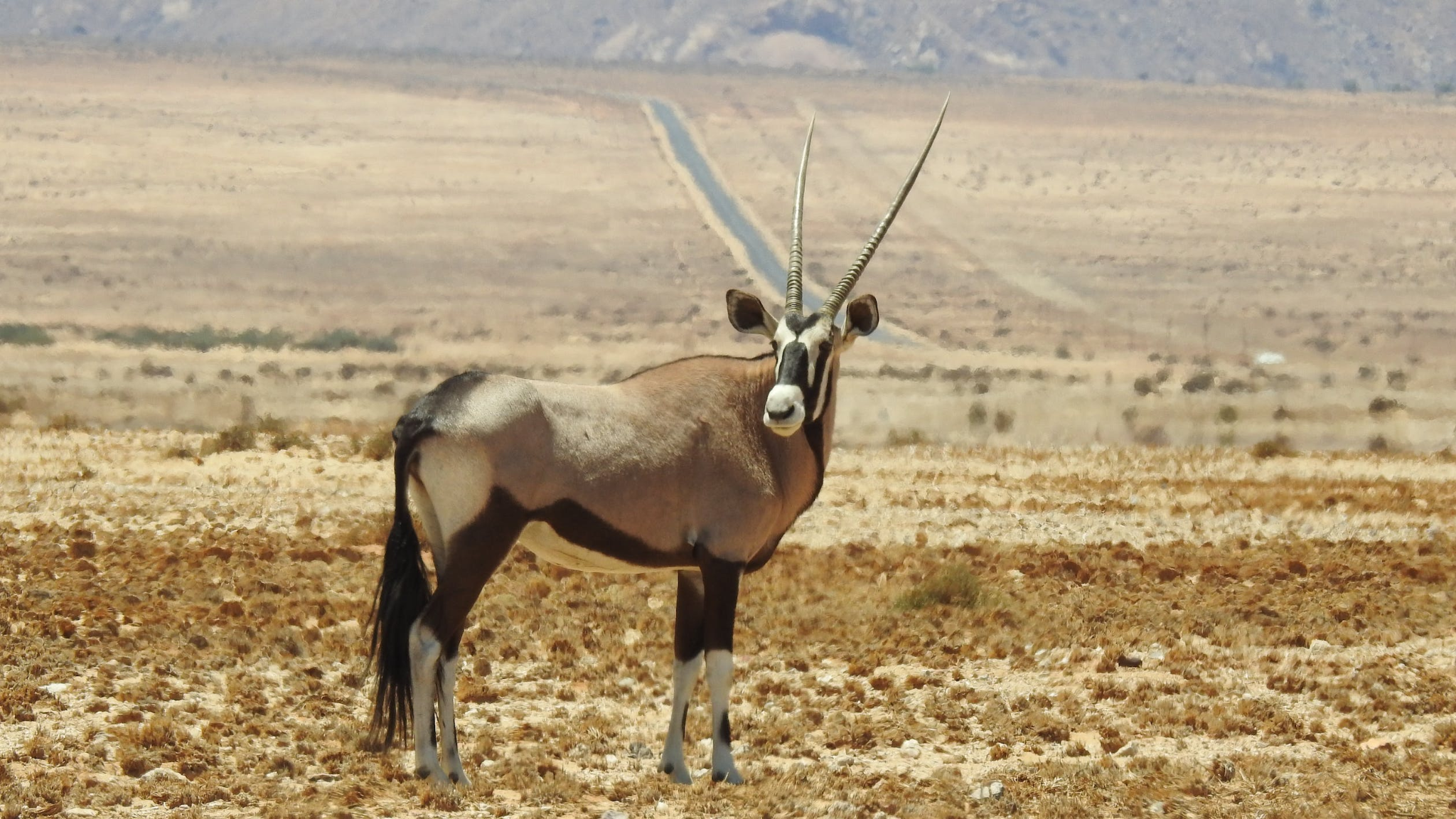
When you think of the national animal of the United Arab Emirates, there is a 99% chance that a camel comes to your mind. This is understandable and expected since a significant area of the country comprises the sprawling desert.
However, let’s burst the bubble. The UAE’s national animal is not the camel or even its distant relative! Then, what is it?
The official national animal of the UAE is the Arabian Oryx. It is one of the largest mammals living in the Arabian Desert. Being an antelope, the Oryx is well-suited to the dry, arid weather of the UAE. Inspiring Arab poetry and literature, these animals are well-known for their grace and endurance.

The Arabian Oryx At A Glance
The Arabian Oryx comes from the desert regions of Iraq, Iran, Saudi Arabia, Syria, Jordan, and Bahrain. Right from ancient times, this animal has been a prominent part of Arabic history, heritage, and culture. Here is what you can learn about Oryx at a glance:
- Common Name: Arabian Oryx (also known simply as Oryx)
- Scientific Name: Oryx leucoryx
- Color: Predominantly radiant white coat, with slightly brownish undersides and legs. Distinct black markings are present at the junction of the head and neck and on the forehead and nose. It has a notably black decorated tail and ears with black tips.
- Height: Between 18 and 35 inches.
- Length: Typically measures 5 to 7 feet.
- Weight: Ranges from 65 kg to 70 kg, depending on the species.
- Lifespan: Can live up to 20 years.
- Diet: Primarily herbivorous, consuming a variety of grasses, roots, shrubs, woody plants, tree bark, and desert cacti. They re-chew their food to help in digestion.
- Offspring: Young ones are referred to as lambs or calves.
- Reproduction: Carries a gestation period of 240 days, usually birthing a single calf at a time.
- Social Behavior: Typically found in groups, with herd sizes ranging from 5 to 30 members.
Though it is also the national animal of Bahrain, Qatar, Oman, and Jordan, it is the most well-known for being the official animal of the United Arab Emirates.
Also Read: Emirates, Qatar Airways, and Etihad Airways: The Ultimate Comparison
Local And Scientific Names Of Oryx
The Arabian Oryx, scientifically called Oryx leucoryx, is also known by several local names such as Maha, Baqar al Aash, Wudhaihi, Boosolah, and Dishon.
Regarding gender classification, male Arabian Oryx are called bucks, while females are designated as does. Their offspring are commonly called lambs or calves.
Must Read before visiting Dubai: Worst Time to Visit Dubai – SKIP THESE MONTHS
What Does The Arabian Oryx Look Like?
The UAE’s national oryx animal features radiant white-hued skin with a prominent brown underside and legs. Both male and female antelopes sport distinctive black stripes at the head and neck junction, foreheads, noses, and from the horns to the mouth.
The Arabian Oryx boasts a unique black, tufted tail and ears with black tips. Both males and females possess straight (sometimes curved) long horns measuring 50-75 cm long.
An adult Arabian Oryx typically weighs between 65-70 kg. Their height ranges from 80 to 105 cm, with their body length about 150-160 cm. It is worth noting that females generally have a longer and slender physique than males.
The Arabian Oryx’s striking white fur deflects sunlight to help regulate their body heat and provides a fascinating contrast against the desert’s golden sands. Their uniquely paddle-like, broad hooves offer an expanded surface area, which helps easily travel the sandy landscapes.

Lifestyle And Habits
Naturally, the Arabian Oryx is a social species that thrives in groups. These groups usually consist of 5 to 30 individual animals. When conditions are favorable, with ample food resources and a healthy environment, the herds tend to be larger.
However, when survival becomes more demanding in challenging weather conditions, the herds often reduce, including only a dominant male, several females, and their offspring. Interestingly, some male Arabian oryx choose a solo existence, looking after expansive territories of their own.

Within these groups, there is a distinct hierarchy order. Members display specific postures to signify their rank, ensuring that combat and potential injuries from their lengthy, sharp horns are minimized.
One fascinating characteristic of the Arabian Oryx is their ability to sense rain from afar. Being nomadic, they roam extensive distances to find fresh vegetation that emerges after irregular rain showers.
The Oryx is most active during the cooler hours of dawn and dusk. They often rest in shaded areas to escape the intense midday heat. At times, they even dig shallow pits in the ground to benefit from the cooler layers of sand.
Diet
The Arabian Oryx is a herbivorous animal. It mainly survives on fresh grass, herbs, roots, and plant tubers. Moreover, they have a remarkable capability to survive days without drinking water and travel to extensive areas.

The Conservation Of The Oryx Species
At the beginning of the 1960s, too much hunting and poaching by the Beduoins had reduced the number of Arabian Oryx to as low as 100 in the whole desert. This was due to the roads and ways created by the oil factories, which made the deserts easily accessible for hunting parties.
This made the conservationists look for a new breeding place for the rapidly-reducing orix species. Hence, Arizona’s Phoenix Zoo was selected to become the new breeding ground for the Oryx due to its hot weather and a climate similar to the Arabian desert.
The breeding location was created in 1962, bringing three wild Arabian oryxes from Yemen, one from London, and five from private collections in Kuwait and KSA.

No oryx was left in the wild by 1972 when the UAE began to develop. However, the Phoenix breeding center had 35 animals ready for other locations.
Eventually, in the 1980s, the numbers grew so much that these animals were released into the wild. However, they were placed in restricted areas where hunting was banned and illegal. Finally, in 2011, the International Union For the Conservation of Nature officially reclassified the Arabian Oryx from endangered to vulnerable because of their growing numbers.
Though this is one of the most captivating conservation success stories ever, the progress is not all positive. In 2007, Oman was the first country to be removed from the World’s Heritage List, UNESCO. This decision was because the Omani government allowed oil exploration in most areas of the country. As a result, the number of Oryx significantly fell from 465 to just 65 from 1996 to 2007.
Today, around 1000 Arabian oryx roam free in the wilds of the Arabian peninsula.
Where To Find The Oryx In The UAE?
In The United Arab Emirates, you can find the Arabian Oryx in the following locations:
1: Abu Dhabi
- Al-Ain Zoo (open to public)
- Arabian Oryx Protective Area (reserved, not available to local civilians)
2: Dubai
- Dubai Desert Conservation Reserve (Desert Safari is available for tourists with approved guides)
- Wadi Al Safa Wildlife Center (not open to the public)
3: Sharjah
- Breeding Center for Endangered Arabian Wildlife (not open to the public)
- Arabian Wildlife Center (public zoo)
Interesting Facts About The Arabian Oryx
Here are some interesting facts about the UAE’s national animal:
- The Arabian Oryx possesses a sharp vision and stays on high alert always.
- When threatened, their instinctual defense mechanism is to lower their heads so that their pointed, elongated horns face forward.
- They possess a unique internal circulation system to cool their blood, adapting to desert climates.
- They are capable of detecting the scent of rain from vast distances.
- Typically, the dominant female leads the herd to areas with fresh vegetation after rainfall.
- Their bright white coat reflects desert sunlight and heat.
- During cold mornings, their dense undercoat retains body warmth.
- Their legs darken in winter to more efficiently absorb solar heat.
- There are myths where it is believed that the Arabian Oryx may be connected to the unicorn legend due to their visual similarities.
- While they aren’t the fastest runners, they can cover up to 60-70 miles per hour due to their incredible speed.
- Their skin doesn’t reflect light, making them hard to spot, even within a 100-meter distance. They seem almost camouflaged.
Conclusion
The Oryx is a distinctive creature native to the Arabian desert and stands as a representative symbol of the United Arab Emirates. It is not just the national animal of the UAE but also deeply represents the spirit and identity of its people.
This animal holds significant cultural and historical value for the nation. Recognizing its importance, the UAE government officially designated the Oryx as the country’s national animal.



